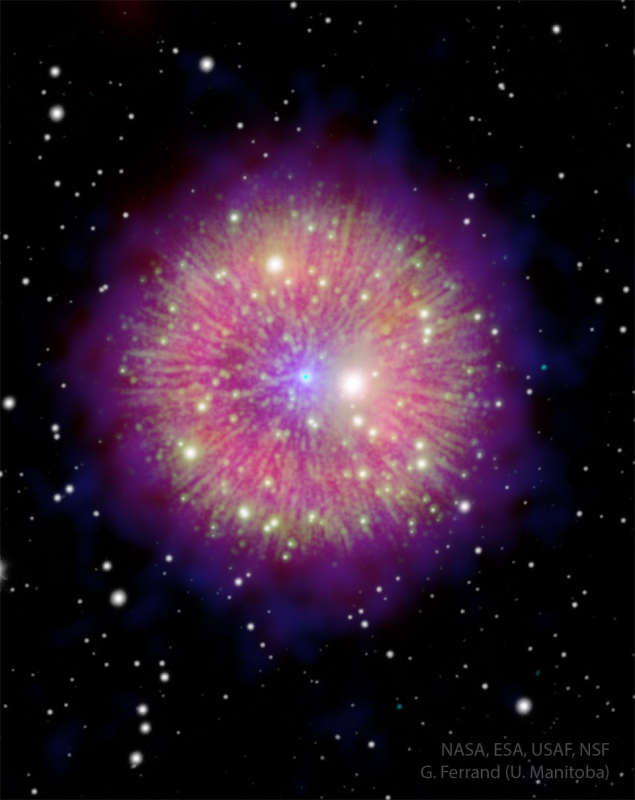
|
Credit & Copyright: NASA,
ESA,
USAF,
NSF;
Processing:
G. Ferrand
(U. Manitoba),
J. English
(U.
Manitoba),
R. A. Fesen
(Dartmouth),
C. Treyturik (U. Manitoba);
Text: G. Ferrand & J. English
Explanation:
What created this unusual celestial firework?
The nebula, dubbed
Pa 30, appears in the same
sky direction now as a bright
"guest star" did in the
year 1181.
Although Pa 30's filaments look similar to that created by a nova
(for example GK Per),
and a planetary nebula (for example
NGC 6751), some astronomers
now propose that it was created by a rare type of
supernova:
a thermonuclear Type Iax, and so is (also) named
SN 1181.
In this model, the supernova was not the result of the
detonation of a single star, but rather a blast that occurred when two
white dwarf stars
spiraled together and merged.
The blue dot in the center is hypothesized to be a
zombie star, the remnant white dwarf that
somehow
survived this
supernova-level explosion.
The featured
image combines images and data obtained with
infrared
(WISE),
visible
(MDM,
Pan-STARRS),
and X-ray
(Chandra, XMM) telescopes.
Future observations and analyses may
tell us more.
NASA Coverage:
Total Solar Eclipse of 2024 April 8
|
January February March April May June July August September October November December |
| ||||||||||||||||||||||||||||||||||||||||||||||||
NASA Web Site Statements, Warnings, and Disclaimers
NASA Official: Jay Norris. Specific rights apply.
A service of: LHEA at NASA / GSFC
& Michigan Tech. U.
Based on Astronomy Picture
Of the Day
Publications with keywords: supernova remnant
Publications with words: supernova remnant
See also:
- APOD: 2025 October 1 Á NGC 6960: The Witchs Broom Nebula
- APOD: 2025 June 9 Á Between Scylla and Charybdis: A Double Cosmic Discovery
- Supernova Remnant Cassiopeia A
- APOD: 2025 January 8 Á Supernova Remnants Big and Small
- APOD: 2024 September 18 Á The Mermaid Nebula Supernova Remnant
- APOD: 2024 April 16 Á Filaments of the Vela Supernova Remnant
- APOD: 2024 March 25 Á Sonified: The Jellyfish Nebula Supernova Remnant
